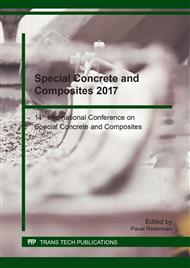[1]
IAEA, The Behaviours of Cementitious Materials in Long Term Storage and Disposal of Radioactive Waste, International atomic energy agency (2013).
Google Scholar
[2]
IAEA, Planning and Design Considerations for Geological Repository Programmes of Radioactive Waste: IAEA-TECDOC-1755, International Atomic Energy Agency (2014).
Google Scholar
[3]
Q.Y. Chen, M. Tyrer, C.D. Hills, X.M. Yang, P. Carey, Immobilisation of heavy metal in cement-based solidification/stabilisation: A review, Waste Manage. 29 (2009) 390-403.
DOI: 10.1016/j.wasman.2008.01.019
Google Scholar
[4]
R. Černý, A. Kunca, V. Tydlitát, J. Drchalová, P. Rovnaníková, Effect of pozzolanic admixtures on mechanical, thermal and hygric properties of lime plasters, Constr. Build. Mater. 20 (2006) 849-57.
DOI: 10.1016/j.conbuildmat.2005.07.002
Google Scholar
[5]
A.E. Lavat, M.A. Trezza, M. Poggi, Characterization of ceramic roof tile wastes as pozzolanic admixture, Waste Manage. 29 (2009) 1666-74.
DOI: 10.1016/j.wasman.2008.10.019
Google Scholar
[6]
A. Moropoulou, A. Bakolas, E. Aggelakopoulou, Evaluation of pozzolanic activity of natural and artificial pozzolans by thermal analysis, Thermochim. Acta. 420 (2004) 135-40.
DOI: 10.1016/j.tca.2003.11.059
Google Scholar
[7]
P. Reiterman, O. Holčapek, K. Polozhiy, P. Konvalinka, Fracture Properties of Cement Pastes Modified by Fine Ground Ceramic Powder, Adv. Mat. Res. 1054 (2014) 182-187.
DOI: 10.4028/www.scientific.net/amr.1054.182
Google Scholar
[8]
S. Roels, J. Carmeliet, H. Hens, O. Adan, H. Brocken, R. Černý, Z. Pavlík, C. Hall, K. Kumaran, L. Pell, J, Interlaboratory comparison of hygric properties of porous building materials, Therm. Envelope Build. Sci. 27 (2004) 307-25.
DOI: 10.1177/1097196304042119
Google Scholar
[9]
ČSN EN 12390-3: Testing of hardened concrete – Part 3: Compressive strength. (2002).
Google Scholar
[10]
User manual. APPLIED PRECISION - ISOMET (1999).
Google Scholar


